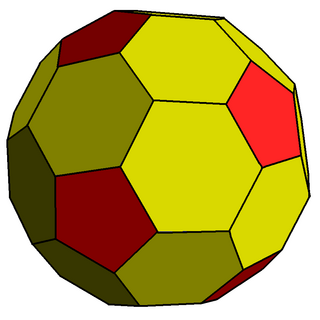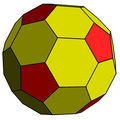Top Qs
Timeline
Chat
Perspective
Chamfered dodecahedron
Goldberg polyhedron with 42 faces From Wikipedia, the free encyclopedia
Remove ads
In geometry, the chamfered dodecahedron is a convex polyhedron with 80 vertices, 120 edges, and 42 faces: 30 hexagons and 12 pentagons. It is constructed as a chamfer (edge-truncation) of a regular dodecahedron. The pentagons are reduced in size and new hexagonal faces are added in place of all the original edges. Its dual is the pentakis icosidodecahedron.
It is also called a truncated rhombic triacontahedron, constructed as a truncation of the rhombic triacontahedron. It can more accurately be called an order-5 truncated rhombic triacontahedron because only the order-5 vertices are truncated.
Remove ads
Structure
These 12 order-5 vertices can be truncated such that all edges are of equal length. The original 30 rhombic faces become non-regular hexagons, and the truncated vertices become regular pentagons.
The hexagon faces can be equilateral but not regular with D2 symmetry. The angles at the two vertices with vertex configuration 6.6.6 are and at the remaining four vertices with 5.6.6, they are ≈121.717° each.
It is the Goldberg polyhedron GV(2,0), containing pentagonal and hexagonal faces.[2]
It also represents the exterior envelope of a cell-centered orthogonal projection of the 120-cell, one of six convex regular 4-polytopes.
Remove ads
Chemistry
The chamfered dodecahedron is the shape of the fullerene C80. Occasionally, this shape is denoted C80(Ih), describing its icosahedral symmetry and distinguishing it from other less-symmetric 80-vertex fullerenes.[2] It is one of only four fullerenes found by Deza, Deza & Grishukhin (1998) to have a skeleton that can be isometrically embeddable into an L1 space.[3]

Related polyhedra
This polyhedron looks very similar to the uniform truncated icosahedron, which has 12 pentagons, but only 20 hexagons.
- Truncated rhombic triacontahedron
G(2,0) - Truncated icosahedron
G(1,1) - cell-centered orthogonal projection of the 120-cell
Related polytopes
It represents the exterior envelope of a cell-centered orthogonal projection of the 120-cell, one of six convex regular 4-polytopes, into 3 dimensions.
References
External links
Wikiwand - on
Seamless Wikipedia browsing. On steroids.
Remove ads






